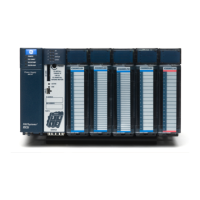Chapter 4. Ladder Diagram (LD) Programming
192 PACSystems* RX7i, RX3i and RSTi-EP CPU Programmer's Reference Manual GFK-2950C
4.10.3 Add
When the ADD function receives power flow, it adds the two
operands IN1 and IN2 of the same data type and stores the sum in
the output variable assigned to Q, also of the same data type.
Mnemonics:
ADD_DINT
ADD_INT
ADD_REAL
ADD_LREAL
ADD_UINT
The power flow output is energized when ADD is performed, unless an invalid operation or Overflow
occurs. (For more information, refer to the section on Overflow.)
Q(16-bit) = IN1(16-bit) + IN2(16-
bit)
base 10 number with sign, up to 5 digits long
Q(32-bit) = IN1(32-bit) + IN2(32-
bit)
base 10 number with sign, up to 10 digits long
Q(32-bit) = IN1(32-bit) + IN2(32-
bit)
base 10 number, sign and decimals, up to 8 digits long
(excluding the decimals)
Q(64-bit) = IN1(64-bit) + IN2(64-
bit)
base 10 number, sign and decimals, up to 17 digits long
(excluding the decimals)
Q(16-bit) = IN1(16-bit) + IN2(16-
bit)
base 10 number, unsigned, up to 5 digits long
Operands of the ADD Function
The value to the left of the plus sign (+) in the equation
IN1+IN2=Q.
The value to the right of the plus sign (+) in the equation
IN1+IN2=Q.
The result of IN1+IN2. If an ADD of signed operands results in
Overflow, Q is set to the largest possible value and there is no
power flow.
If an ADD_UINT operation results in Overflow, Q wraps around.
All except S, SA, SB, SC
and constant.

